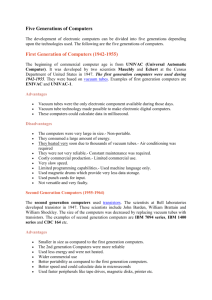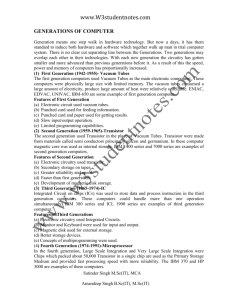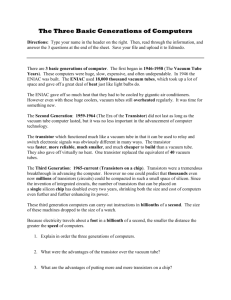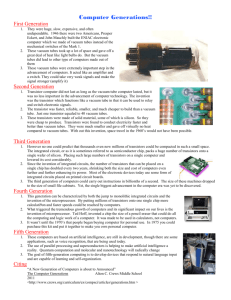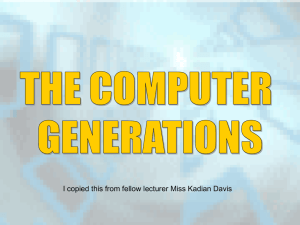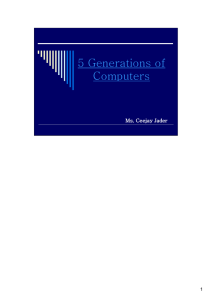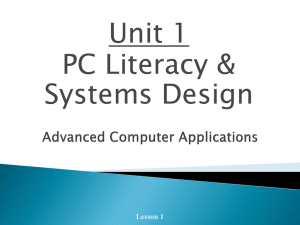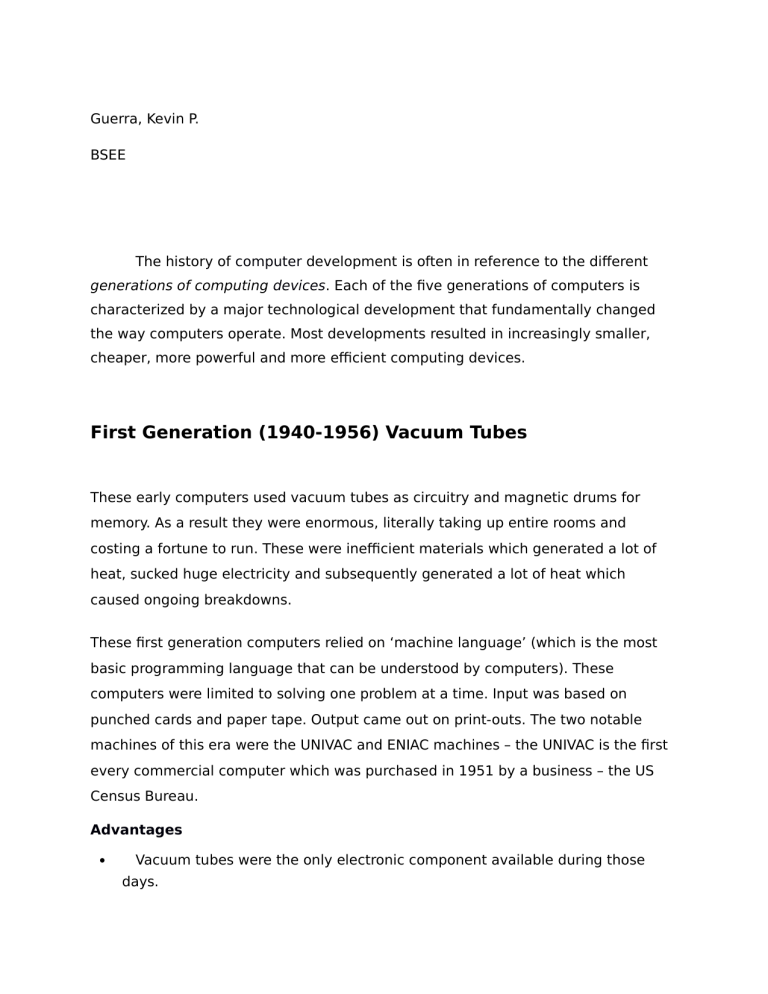
Guerra, Kevin P. BSEE The history of computer development is often in reference to the different generations of computing devices. Each of the five generations of computers is characterized by a major technological development that fundamentally changed the way computers operate. Most developments resulted in increasingly smaller, cheaper, more powerful and more efficient computing devices. First Generation (1940-1956) Vacuum Tubes These early computers used vacuum tubes as circuitry and magnetic drums for memory. As a result they were enormous, literally taking up entire rooms and costing a fortune to run. These were inefficient materials which generated a lot of heat, sucked huge electricity and subsequently generated a lot of heat which caused ongoing breakdowns. These first generation computers relied on ‘machine language’ (which is the most basic programming language that can be understood by computers). These computers were limited to solving one problem at a time. Input was based on punched cards and paper tape. Output came out on print-outs. The two notable machines of this era were the UNIVAC and ENIAC machines – the UNIVAC is the first every commercial computer which was purchased in 1951 by a business – the US Census Bureau. Advantages Vacuum tubes were the only electronic component available during those days. Vacuum tube technology made possible to make electronic digital computers. These computers could calculate data in millisecond. Disadvantages The computers were very large in size. They consumed a large amount of energy. They heated very soon due to thousands of vacuum tubes. They were not very reliable. Air conditioning was required. Constant maintenance was required. Non-portable. Costly commercial production. Limited commercial use. Very slow speed. Limited programming capabilities. Used machine language only. Used magnetic drums which provide very less data storage. Used punch cards for input. Not versatile and very faulty. Second Generation (1956-1963) Transistors The replacement of vacuum tubes by transistors saw the advent of the second generation of computing. Although first invented in 1947, transistors weren’t used significantly in computers until the end of the 1950s. They were a big improvement over the vacuum tube, despite still subjecting computers to damaging levels of heat. However they were hugely superior to the vacuum tubes, making computers smaller, faster, cheaper and less heavy on electricity use. They still relied on punched card for input/printouts. The language evolved from cryptic binary language to symbolic (‘assembly’) languages. This meant programmers could create instructions in words. About the same time high level programming languages were being developed (early versions of COBOL and FORTRAN). Transistor-driven machines were the first computers to store instructions into their memories – moving from magnetic drum to magnetic core ‘technology’. The early versions of these machines were developed for the atomic energy industry. Advantages Smaller in size as compared to the first generation computers. The 2nd generation Computers were more reliable Used less energy and were not heated. Wider commercial use Better portability as compared to the first generation computers. Better speed and could calculate data in microseconds Used faster peripherals like tape drives, magnetic disks, printer etc. Used Assembly language instead of Machine language. Accuracy improved. Disadvantages Cooling system was required Constant maintenance was required Commercial production was difficult Only used for specific purposes Costly and not versatile Puch cards were used for input. Third Generation (1964-1971) Integrated Circuits By this phase, transistors were now being miniaturised and put on silicon chips (called semiconductors). This led to a massive increase in speed and efficiency of these machines. These were the first computers where users interacted using keyboards and monitors which interfaced with an operating system, a significant leap up from the punch cards and printouts. This enabled these machines to run several applications at once using a central program which functioned to monitor memory. As a result of these advances which again made machines cheaper and smaller, a new mass market of users emerged during the ‘60s. Advantages Smaller in size as compared to previous generations. More reliable. Good storage Used less energy Versatile to an extent Produced less heat as compared Less expensive Better accuracy Commercial production to the previous two generations of computers. Better speed and could calculate data in nanoseconds. Used fan for heat discharge to increased. input. prevent damage. Maintenance cost was low because hardware failure is reare. Totally general purpose Could be used for high-level languages. Used mouse and keyboard for Disadvantages Air conditioning was required. Highly sophisticated technology required for the manufacturing of IC chips. Fourth Generation (1971-Present) Microprocessors This revolution can be summed in one word: Intel. The chip-maker developed the Intel 4004 chip in 1971, which positioned all computer components (CPU, memory, input/output controls) onto a single chip. What filled a room in the 1940s now fit in the palm of the hand. The Intel chip housed thousands of integrated circuits. The year 1981 saw the first ever computer (IBM) specifically designed for home use and 1984 saw the MacIntosh introduced by Apple. Microprocessors even moved beyond the realm of computers and into an increasing number of everyday products. The increased power of these small computers meant they could be linked, creating networks. Which ultimately led to the development, birth and rapid evolution of the Internet. Other major advances during this period have been the Graphical user interface (GUI), the mouse and more recently the astounding advances in lap-top capability and hand-held devices. Advantages More powerful and reliable than previous generations. Small in size Fast processing power with less power consumption Fan for heat discharging and thus to keep cold. No air conditioning required. Totally general purpose Commercial production Less need of repair. Cheapest among all generations All types of High level languages can be used in this type of computers Disadvantages The latest technology is required for manufacturing of Microprocessors. Fifth Generation (Present and Beyond) Artificial Intelligence Computer devices with artificial intelligence are still in development, but some of these technologies are beginning to emerge and be used such as voice recognition. AI is a reality made possible by using parallel processing and superconductors. Leaning to the future, computers will be radically transformed again by quantum computation, molecular and nano technology. The essence of fifth generation will be using these technologies to ultimately create machines which can process and respond to natural language, and have capability to learn and organise themselves.
